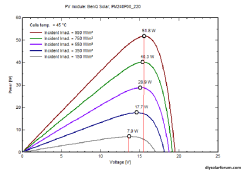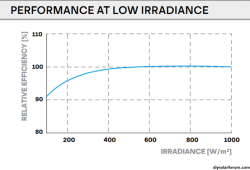For example, today I have light but consistent cloud cover, the sort of thing where you don't get shadows but it's bright. My panels were producing about 1/3 of what they are capable of.
Notably the Panasonic panels were doing rather better than the LG or Jinko panels. They do seem to be notably more efficient in lower light conditions.
Thanks Quattro
Have you ever taken a solar intensity meter to quantify the production?
For example, Sunshine_Eggo puts up this graph here for his panels:

I need a simple MPPT for my 1kW system, 6S2P of 85W panels (22.7Voc, so 136.2Voc for the whole system). I stupidly disconnected my Outback FM-80 from the battery without realizing it, and fried it. So be it. The panels are not easily accessible/rewireable, so they're going to stay in that...

diysolarforum.com
Meanwhile, the panels I am seriously considering from Signature Solar, these Canadian Solar 390W beauties show nearly 90% of max production at meager 100W/m2;

So, as they say, your mileage may vary - and vary quite a bit.
My situation in Minnesota is probably typical for the state:
- On bright sunny days we do get 1000W/m2, especially in the summer (when we need the power for the air conditioning the most)
- On dreary overcast days, the meter says 150W/m2 through the leaves - when they fall next month I will get a better reading.
I would like to put 10 panels on a rack to begin with for 3900W theoretical and 1800W expected in practice
I could place them on a roof, but I REALLY do not want climb and deal with that install, not till the rack system provides some meaningful battery back up for nearly once a month our grid goes down these days...
So if these 10 panels act as a "good enough" trickle charger to keep a couple of EG4's batteries store 10KW-h for those black outs and maybe cut down our electric bill by a third or so...
If/when that happens, I can be inspired to climb the roof come next summer and add/move panels for a 20panel+ system to give 9 theoretical KWs to really dent the grid consumption...
Thanks again.
Any thoughts appreciated.





